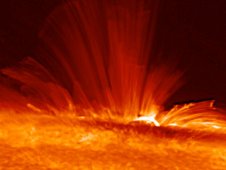Since the early days of the space program, NASA's Marshall Space Flight Center has expanded human understanding through scientific exploration of the Earth, our solar system and the universe. With a rich heritage in developing spacecraft that deliver amazing scientific discoveries, Marshall uses the resulting knowledge to create a clearer picture of the universe, expand humanity's reach into the cosmos and provide benefits on Earth.
For example,
Earth scientists use satellites and advanced technologies to gather data on powerful hurricanes, lightning and tornadoes, helping forecasters to more accurately predict, track and alert the public to severe weather -- saving lives and property all around the world. Satellite data also contribute directly to improving agriculture and urban planning and to preventing the spread of disease.
Solar scientists at Marshall are examining the sun’s influence on our planet. They use telescopes and probes to study how the sun works, how it changes and how these changes affect the Earth. The resulting "space weather" -- energetic particles emitted during solar flares and other eruptions on the sun -- can have adverse effects on orbiting satellites and astronauts, and even interfere with electrical and communications systems here on Earth.
Marshall-managed space science projects and programs send unmanned satellites and probes into Earth orbit and throughout our solar system. These sophisticated spacecraft and instruments include the
Hubble Space Telescope and the
Chandra X-ray Observatory, which send unprecedented images and information about the
universe and its environments back to Earth -- helping us decipher the origin, structure and evolution of the universe. The knowledge gained from these probes and observatories has dramatically enhanced and revised humanity's understanding of the universe and advanced technology on Earth.
Marshall is preparing to extend human reach in space, by developing NASA's next-generation heavy-lift launch vehicle, the Space Launch System, which will make it possible to transport larger scientific payloads farther into space than ever before. This could include larger telescopes with apertures of 10-30 meters (compared with the James Webb Space Telescope's unprecedented 6.5-meter aperture) to larger spacecraft and surface "rovers" that explore the outer planets and their moons. This new generation of rockets will enable a new era of extraordinary scientific discovery, and Marshall scientists and researchers will lead the way.
 Stay connected with Marshall and its growing social media communities.
Stay connected with Marshall and its growing social media communities. 


 Hinode image of the magnetic field around a sunspot. (Hinode JAXA/NASA)
Hinode image of the magnetic field around a sunspot. (Hinode JAXA/NASA)